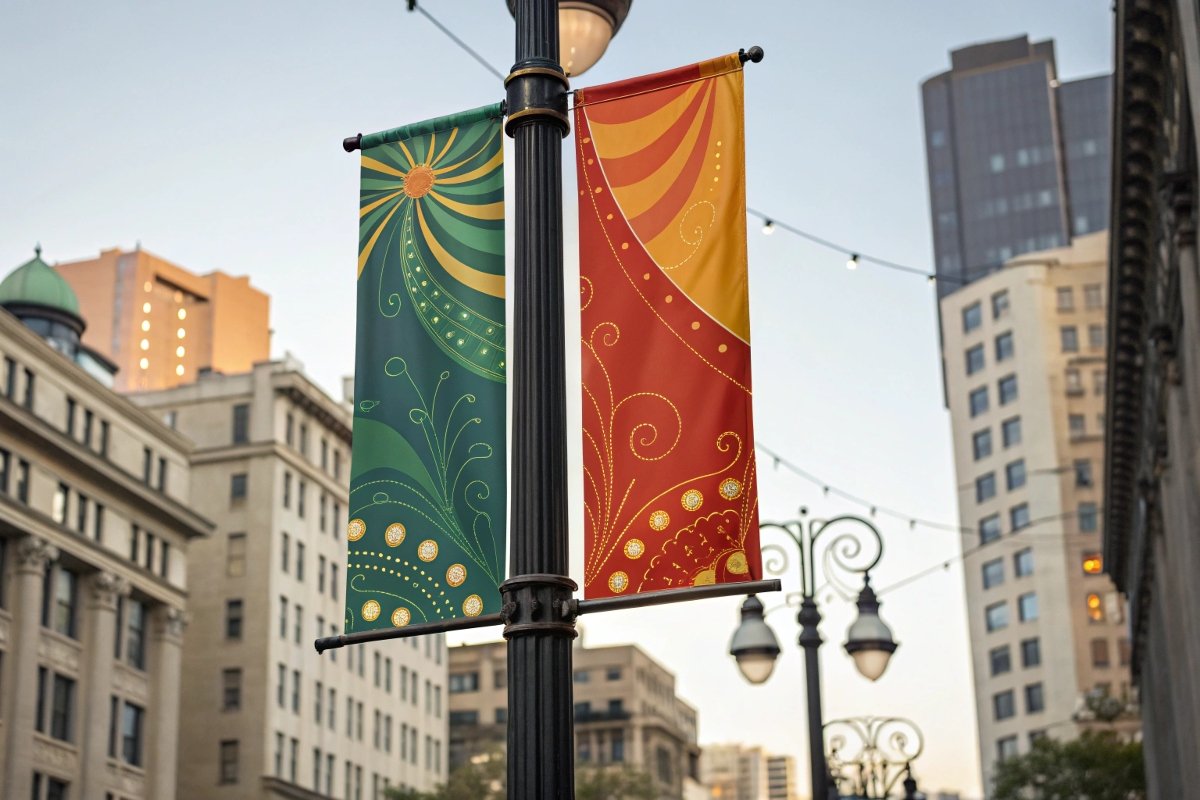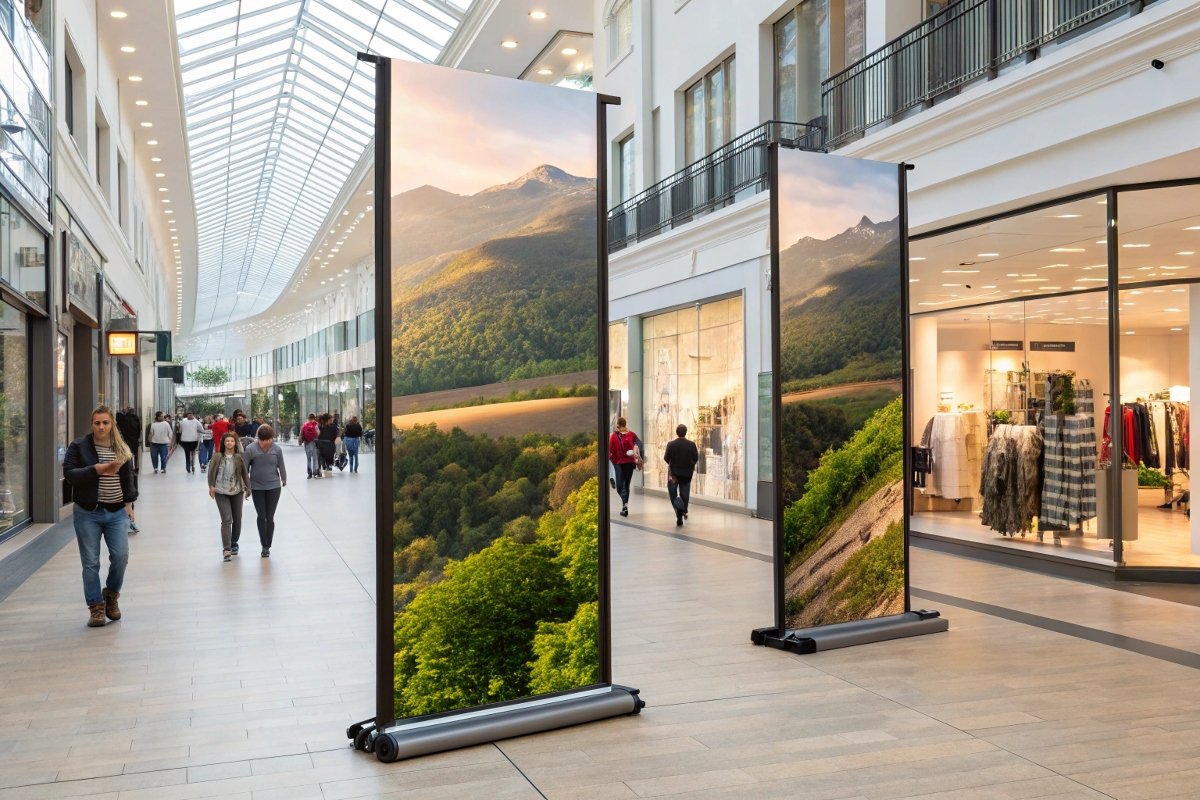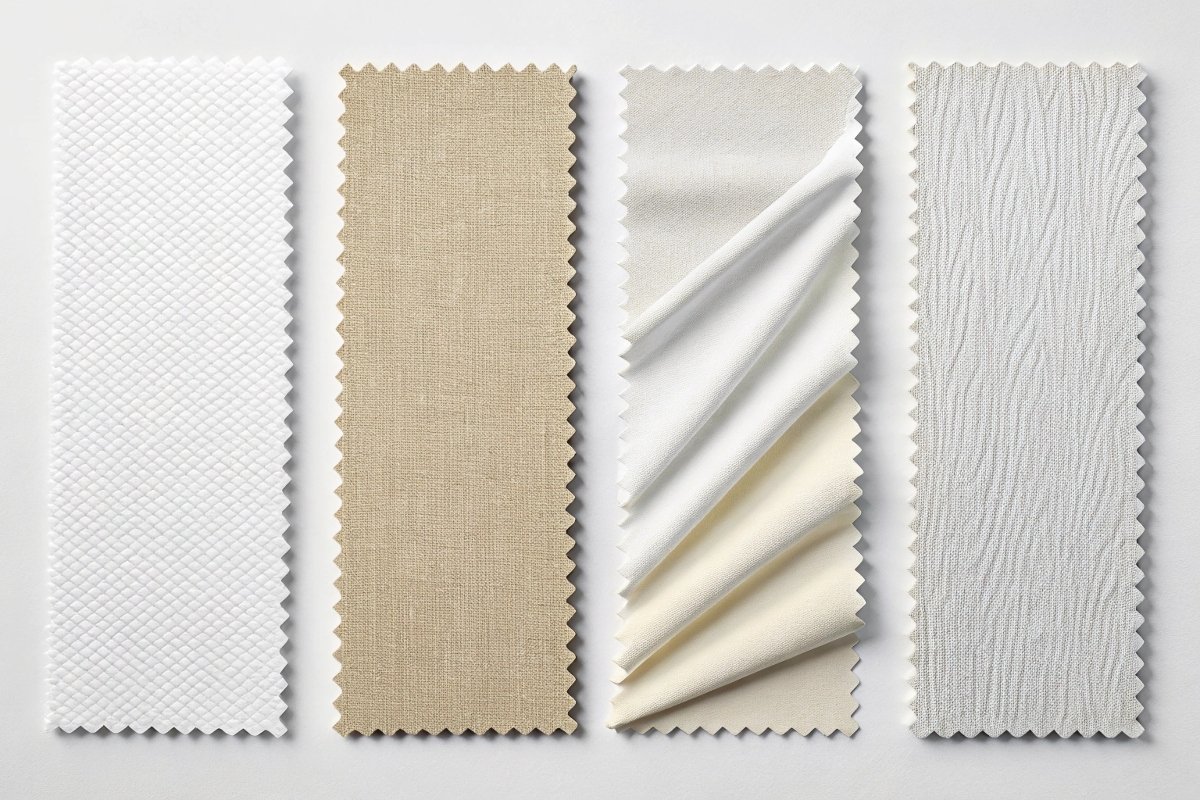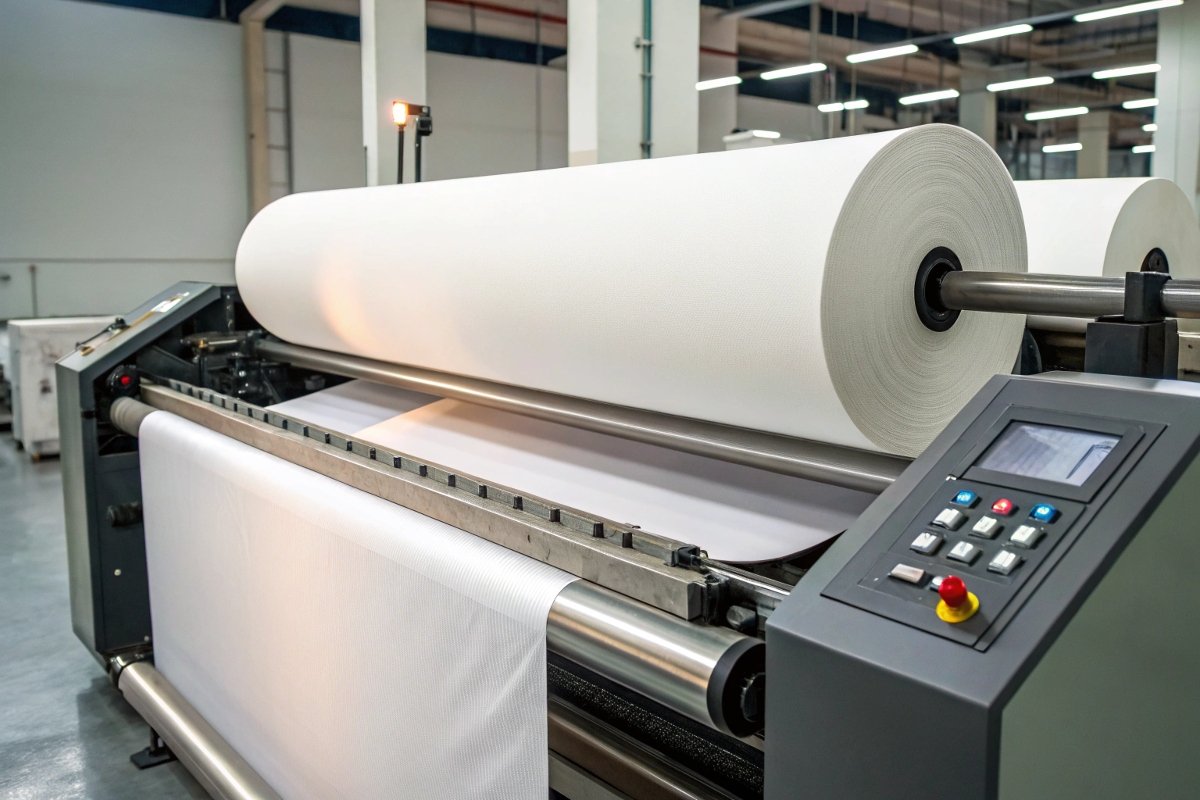Have you ever walked by a street sign and seen a perfect ad no matter which way you looked? That's the magic of a double-sided banner. It means twice the visibility for your message!
Double-sided banners are advertising displays printed on both sides, designed to convey different messages or the same message to viewers approaching from multiple directions. They are typically made from materials engineered to prevent print show-through, ensuring clarity and impact from either side.

My journey in the signage industry has shown me how crucial visibility is. Early in my career, I remember working on projects where the client needed their message seen from every angle. This led me to truly appreciate the engineering behind double-sided banners. They solve a very specific problem: maximizing exposure in high-traffic areas. I recall back in 2010, we had the incredible opportunity to be part of the iPhone 4 advertising launch in China. Our company provided the excellent drape-style double-sided banners for their store signs. We used a 300Dx300D, 40x42 weave, specifically a blackout[^1] double-sided banner. That project really highlighted the difference true quality can make.
What are the Applications of Double-sided Banners?
Double-sided banners are incredibly versatile. They are used in many places where messages need to be seen from more than one direction.
Double-sided banners are ideal for applications requiring maximum visibility and message delivery from multiple angles, such as retail promotions, street advertising, event signage, and point-of-sale displays. Their dual-sided nature ensures that a brand's message is always exposed to passersby, regardless of their approach.

In my experience, the greatest advantage of a double-sided banner is its efficiency. Why use two separate signs when one can do the job better? This thinking leads to smart applications. For instance, double-sided pole banners[^2] are common on city streets. They catch eyes from both directions. We also see double-sided pop-up banners[^3] and double-sided retractable banners[^4] used a lot at trade shows. They are easy to set up and take down, and they work well in busy indoor spaces. Flag banners, like feather banners[^5] and teardrop banners[^6] with double-sided printing, flutter in the wind while still showing the message.
Common Applications of Double-Sided Banners
| Application Type | Description | Key Advantage | Typical Materials Used |
|---|---|---|---|
| Double-Sided Pole Banners | Banners hung from street poles; common in cities and campuses. | Maximum street visibility for events and general advertising. | Vinyl banner, blackout flex |
| Double-Sided Pop-Up Banners | Portable, self-standing displays for events and trade shows. | Easy setup, high impact in temporary locations. | Display fabric[^7], vinyl |
| Double-Sided Pull-Up Banners | Retractable stands for quick display at exhibitions or retail. | Convenient for mobile marketing, conserves space. | PET banner[^8], PP film[^9], display fabric |
| Double-Sided Flag Banners | Includes feather, teardrop, and rectangular flags. | Dynamic visual appeal, great for outdoor events. | Flag fabric[^10] |
| Double-Sided Mesh Banners[^11] | Perforated banners for windy conditions, allows air flow. | Reduces wind load, prevents tearing in outdoor settings. | Mesh banner (PVC or textile based) |
| Double-Sided Twist Banners[^12] | Unique twist-folding display; often used for event backdrops. | Innovative design, strong visual presence for branding. | Display fabric, vinyl |
What are the Fabric Options for Double-sided Banners?
The material a double-sided banner is made from is crucial. It affects durability, appearance, and how it can be printed.
The primary fabric options for double-sided banners include vinyl banner material, mesh banner material, PET banner, PP film, flag fabric, and display fabric. The choice of material depends on factors such as required durability, transparency (or lack thereof), print quality needs, and the specific application environment (e.g., indoor, outdoor, windy conditions).

When nlsigns.com sources materials for our clients, we always discuss their specific needs. For heavy-duty outdoor banners, a strong vinyl banner with a blackout layer is often the best choice. This blackout layer is what prevents one side's print from showing through to the other. Mesh banners are great for windy locations because the perforations let air pass through. For indoor displays where image quality is paramount and light needs to be managed, PET banner or PP film might be considered. Fabric options like flag fabric and display fabric offer a softer look and better drape. They are often chosen for retail or event settings where a less rigid feel is desired.
Fabric Options for Double-Sided Banners
| Fabric Type | Description | Key Characteristics | Best For |
|---|---|---|---|
| Vinyl Banner | Heavy-duty PVC material, often with a blackout layer in the middle. | Excellent durability, weather resistance, vibrant print. | Outdoor pole banners, large building wraps. |
| Mesh Banner | Perforated PVC or textile, allowing wind to pass through. | Wind-resistant, good for large outdoor installations. | Fences, building facades in windy areas. |
| PET Banner | Polyester (PET) film, sometimes with coating. | High print resolution, good flatness, often eco-friendly | Roll-up banners, indoor displays. |
| PP Film | Polypropylene film, lightweight and often economical. | Smooth surface, good for indoor roll-ups. | Promotional displays, quick event signage. |
| Flag Fabric | Lightweight polyester textile. | Good drape, often translucent, vibrant colors. | Feather flags, teardrop flags, street flags. |
| Display Fabric | Various polyester textiles, often thicker than flag fabric. | Softer feel, good for backdrops, exhibition graphics. | Pop-up displays, tension fabric systems. |
How to Print Double-Sided Banners?
Printing double-sided banners requires specific equipment and techniques to ensure both sides look great without affecting each other.
Printing double-sided banners typically involves specialized double-sided printers that can print both sides of a material simultaneously or consecutively with precision registration. UV printing is a common method for non-textile materials like vinyl and mesh banners. For fabric banners, dye-sublimation or direct-to-fabric printing are often used, with considerations for show-through depending on the fabric type.

When we produce double-sided banners, especially for those high-profile projects, the printer itself makes a huge difference. For vinyl, mesh, PET, and PP film banners, we often use advanced double-sided printers. The ones by Skyjet, Durst P series[^13], HP Scitex[^14], and EFI VUTEk Q series[^15] are excellent examples. These machines primarily use UV printing[^16] technology. UV printing cures the ink instantly with ultraviolet light, which means the ink doesn't penetrate the material deeply. This is very important for preventing show-through and achieving vivid colors on both sides.
For flag fabric and display fabric, the printing methods are different. We favor textile printers like those from Atexco[^17]. These usually employ dye-sublimation[^18] or direct-to-fabric printing. For some textiles, you can even achieve a "single-sided print with show-through" effect. This means you print on one side, and the color bleeds through to the other side. This results in a slightly lighter, mirrored image on the back. It still gives a double-sided look, but with a subtle difference in color intensity. For backlit fabric displays, printing on both sides or even using multiple layers of fabric can enhance the color saturation, making the banner appear more vibrant both day and night.
Double-Sided Banner Printing Methods
| Material Type | Primary Printing Method | Key Characteristics | Example Printers (High End) | Notes |
|---|---|---|---|---|
| Vinyl Banner, Mesh Banner, PET Banner, PP Film | UV Printing | Ink cured instantly, minimal show-through, durable. | Skyjet, Durst P series, HP Scitex, EFI VUTEk Q series | Often require dedicated double-sided printers for speed and accuracy. |
| Flag Fabric, Display Fabric (Textile) | Dye-Sublimation, Direct-to-Fabric Printing | Colors penetrate fibers, vibrant, soft feel. | Atexco | 'Show-through' effect possible for flag fabric; multi-pass/layers for backlighting. |
How to Print Double-Sided Mesh Banners?
Double-sided mesh banners have unique requirements. Just letting the wind through isn't enough; they also need to look good from both sides.
Printing double-sided mesh banners shares similarities with other double-sided materials but requires careful attention to the material's perforated nature. UV printing is the preferred method, utilizing specialized double-sided printers that can handle the mesh structure. The ink must adhere well to the PVC coating and efficiently cover the mesh holes to ensure a clear image on both sides without excessive ink bleed.

When it comes to mesh banners, the challenge is always the holes. You need the print to be solid enough to cover the mesh effectively. This is where UV printing shines. The ink sits on the surface and cures quickly, which prevents it from bleeding through the perforations excessively. We also need to be careful with ink coverage to ensure that the image on one side doesn't look patchy or weak due to the other side's print or the mesh structure itself. Choosing the right density of mesh and ensuring the printer's setup is optimized for it are critical steps. This ensures that even with the air permeable design, the visual quality from both sides remains high.
Printing Double-Sided Mesh Banners
| Aspect | Consideration | Method/Reasoning | Resulting Benefit |
|---|---|---|---|
| Material Choice | Mesh density and hole size. | Choose mesh suitable for print detail vs. wind porosity. | Optimal balance of image clarity and wind relief. |
| Printing Method | Primarily UV printing. | Ink cures on surface, preventing bleed-through via holes. | Sharp, vibrant image on both sides. |
| Printer Type | Dedicated double-sided mesh/vinyl printer. | Ensures precise registration and efficient production. | High quality and cost-effective output. |
| Ink Adhesion | Specific UV inks for PVC-coated mesh. | Ensures durability and strong color reproduction. | Long-lasting banners in outdoor conditions. |
Conclusion
Double-sided banners offer maximum visibility for your message, printed on both sides with specialized materials like vinyl or fabric, using UV or dye-sublimation methods. Their applications range from street poles to event displays, making them versatile and impactful.
Annotated Reading:
- Blackout (Banner Material): A type of banner material that has an opaque layer (often black) in the middle, specifically designed to prevent light from passing through. This ensures that graphics printed on one side of a double-sided banner do not show through to the other side.
- Double-sided Pole Banners: Banners designed to be displayed on light poles or street poles, visible from both directions of traffic.
- Double-sided Pop-Up Banners: Portable, free-standing banner displays that "pop up" or expand into shape, often used for trade shows, events, or in-store promotions, with graphics on both sides.
- Double-sided Ret retractable Banners: Also known as pull-up banners, these are portable display stands where the banner graphic retracts into a base for easy transport and setup. Double-sided versions allow for display on two faces.
- Feather Banners: Tall, vertical flag banners characterized by their feather-like shape, often used outdoors for advertising and events. Double-sided versions ensure visibility from all angles.
- Teardrop Banners: Flag banners shaped like a teardrop, designed for outdoor use and often seen at events or storefronts. Double-sided versions ensure continuous visibility.
- Display Fabric: A broad term for textile materials specifically designed for graphic displays, often made of polyester, known for their softness, wrinkle resistance, and printability for indoor applications.
- PET Banner (Polyethylene Terephthalate Banner): A type of banner material made from polyester film, often chosen for its smooth surface, excellent print quality, and environmental considerations (recyclability).
- PP Film (Polypropylene Film): A lightweight, low-cost film often used for indoor banner applications like roll-ups or posters, known for its smooth surface.
- Flag Fabric: Lightweight, permeable textile material designed for printing flags, allowing them to flutter easily in the wind. Typically polyester.
- Mesh Banner: A type of banner material with small holes or perforations throughout its surface, which allows wind to pass through, reducing banner flapping and potential damage in windy conditions. Commonly used for large outdoor signs on fences or buildings.
- Double-sided Twist Banners: Portable, collapsible banner displays that twist and fold into a compact shape for storage, often used for backdrops or event signage.
- Durst P Series: A line of high-end, industrial-grade UV inkjet printers manufactured by Durst Phototechnik AG, known for their excellent print quality and productivity in wide-format applications. https://www.durst-group.com/
- HP Scitex: A brand of industrial wide-format inkjet printers, specializing in digital presses for signage, display, and corrugated packaging, developed by HP (Hewlett-Packard). https://www.hp.com/
- EFI VUTEk Q Series: A series of ultra-high-speed, superwide-format UV inkjet printers from Electronics For Imaging (EFI), designed for high-volume production of signage and display graphics. https://www.efi.com/
- UV Printing: A type of digital printing that uses ultra-violet (UV) lights to cure or dry ink as it is printed. The liquid ink instantly turns into a solid, allowing printing on a wide range of materials and providing durable, vibrant results. https://en.wikipedia.org/wiki/UV_curable_ink
- Atexco: A Chinese manufacturer specializing in digital textile printing solutions, including dye-sublimation and direct-to-fabric printers, widely used in the textile industry. https://www.atexco.com/
- Dye-Sublimation (Printing): A printing process that uses heat to transfer dye onto materials like fabric. The dye turns into a gas when heated and permeates the material, resulting in permanent, vibrant, and high-resolution prints, especially on polyester textiles. https://en.wikipedia.org/wiki/Dye-sublimation_printer


